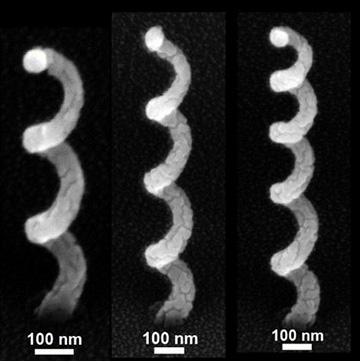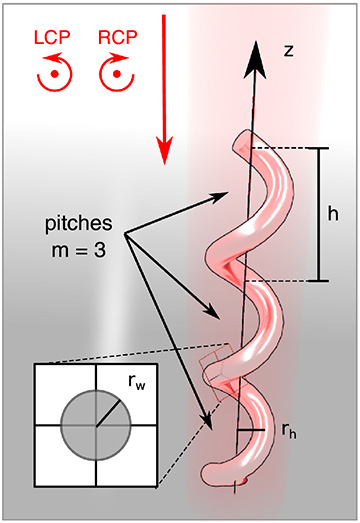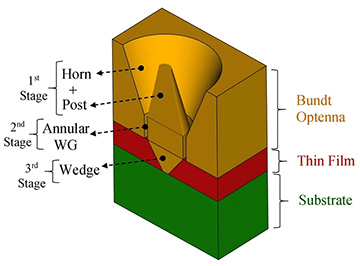
Recent work by two research groups explored the design of plasmonic nanoantennas, such as helical antennas (shown here) for capturing chiral visible light and Bundt-pan-shaped nanoscale structures for infrared devices. [Image: HZB]
As optoelectronic devices get ever smaller, it becomes ever more difficult to gather in and enhance faint optical signals for useful work in sensing and communications. In two recent studies, different research groups unveiled approaches to the design of nanoscale plasmonic antennas that could help in the quest.
In one study, a research team in Germany developed a framework that should dramatically simplify the design and manufacture of corkscrew-like, chiral nanoantennas to capture and amplify circularly polarized light—potentially useful in sensors used to identify biomolecules with a specific “handedness.” And, in the other, a scientist in Saudi Arabia modeled a nanoscale antenna, shaped like a Bundt baking pan, that reportedly can enhance the power absorption efficiency of infrared radiation by up to eight orders of magnitude.
Designing helical antennas
The interaction with matter of chiral light—light that, by virtue of its circular polarization, has a natural “handedness” related to its polarization direction—has a range of potentially intriguing applications. That’s particularly true in biochemistry and pharmaceuticals, where distinguishing left-handed molecules from right-handed ones can mean the difference between a effective drug and a dangerous one (see “Chiral Nanomaterials and Chiral Light,” OPN, July/August 2016).
The problem, however, is that the interaction of chiral light with chiral molecules—whether DNA strands, amino acids or other natural substances—tends to be on the weak side. One way to get around that is to beef up the optical signal through some sort of helical, or corkscrew-shaped, metal nanoantenna with its own sense of handedness, which plasmonically enhances chiral light and thus boosts its interaction with chiral molecules.
But designing such antennas turns out to be a difficult problem for light in the visible spectral range. That’s because, in these wavelengths, the resonance patterns of helical antennas can vary in complicated ways depending on length, symmetry, number of turns, plasmonic losses and other parameters. As a result, up to now, the design of such nanoantennas has had to rely on complex numerical simulations, in the absence of an analytical equation capturing all of the variables.
Doing the math

The team at the Helmholtz Zentrum für Materialien und Energie looked at a variety of parameters for chiral plasmonic nanoantennas, and rolled them into a single analytical equation that could guide design. [Image: K. Höflich et al., Optica, doi: 10.1364/OPTICA.6.001098 (2019); CC-BY 4.0]
A team led by Katja Höflich of the Helmholtz Zentrum für Materialien und Energie, Berlin, Germany, has now done the heavy lifting to come up with just such an analytical equation—and to put it to use in creating silver corkscrew nanoantennas (Optica, doi: 10.1364/OPTICA.6.001098).
Höflich and her team looked carefully at the interplay of geometry, length and material properties in such antennas. Then, in an elegant bit of mathematical reasoning, the researchers were able to roll those parameters up into a formula that fully captured the resonance behavior of visible-light helix antennas for “all orders excited by any handedness of the incident light.”
With the equation in hand, they used it as a tool for designing plasmonic nanoantennas. Then the team turned to fabricating them, via a clever setup in which a scaffold is first created with electron-beam-induced deposition, and then sputter-coated with silver. The scientists found that the chiroptical response of the fabricated antennas agreed well with the predictions of the analytical model.
“We now have a formula that tells us how a nanoantenna with specific parameters responds to light,” Höflich said in a press release accompanying the research. She and her team believe that tool could be useful not only in designing applications in molecular sensing for biomedicine and pharmaceutical development, but also in possible computing schemes based on the spin quantum number of light.
Boosting infrared signals
Meanwhile, OSA Senior Member Ehab Awad, at King Saud University, Saudi Arabia, was tackling a different problem: how to amplify weak infrared signals in increasingly small nanophotonic devices such as photodetectors, photovoltaics, cameras and microbolometers (Sci. Reports, doi: 10.1038/s41598-019-48648-6). Shrinking these devices has obvious advantages in speed, field operation, resolution and integration with other components. But it also shrinks the aperture for the antennas—meaning that the devices can have trouble pulling in enough infrared radiation to do the job.
Here again, plamsonic nanoantennas offer a natural solution to the problem. Such antennas, by concentrating and enhancing light fields into a small area, can significantly boost the absorption of optical energy from free space. But it’s been tough to design nanoscale plasmonic antennas that combine broadband operation, insensitivity to polarization of the light, and wide field of view—all while keeping the losses endemic to plasmonic devices to a minimum, and efficiently focusing the light down to a subwavelength area.
A “Bundt optenna”

To get to a broadband, polarization-insensitive plasmonic antenna for infrared radiation, a researcher at King Saud University turned to the shape of a classic Bundt baking pan. [Image: E. Awad, Sci. Reports, doi: 10.1038/s41598-019-48648-6 (2019); CC-BY 4.0]
Taking all of these factors into account, Awad designed an “optenna” that, when arranged in a device in a periodic array, he believes could do the trick. The proposed gold plasmonic antenna is shaped like a classic “Bundt” baking pan, with a conical projection in the center and sloped sides, creating a relatively large input aperture that focuses incident light down to a 50-nm-wide footprint. The 2-D symmetry of the design makes it polarization-insensitive, and the horn structure sports a broadband response.
Awad tested the design using finite-difference time-domain modeling, and reports that the simulations revealed that such an antenna showed an “enhanced power efficiency up to eight orders of magnitude,” with a “reasonable” average power loss of –3 dB and an 80-degree field of view. In an e-mail to OPN, Awad noted that the optenna could “work across the near-infrared, shortwave, and mid-wave infrared bands,” and suggested it was promising for nanoscale infrared devices ranging from solar cells to photodetectors to shortwave cameras and midwave microbolometers.
